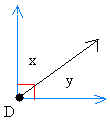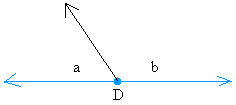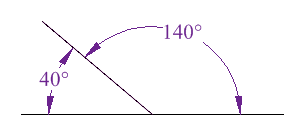Complementary angles:
Two angles whose measures add to 90 degrees. It is easy to see when the angles are adjacent like the following:
Angles x and y are adjacent because they share a ray (line in black) and a vertex (point in black called D).
Now why are they complementary?
Notice also that the angle in blue measures 90 degrees
Since the measure of angle x plus the measure of angle y = 90 degrees, x and y are complementary
Angles do not have to be adjacent to be complementary. The following angles are also complementary as long as the sum of the measures equal 90 degrees
Supplementary angles:Two angles whose measures add to 180 degrees. It is easy too to see this when the angles are adjacent like the following:
Again, angles a and b adjacent because they share a ray (line in black) and a vertex (point in black called D), so they are adjacent angles.
Now why are they supplementary?
Notice also that the angle in blue measures 180 degrees because the angle is a striaght line and a straight line measures 180 degrees
Since the measure of angle a plus the measure of angle b = 180 degrees, a and b are supplementary
Again, angles do not have to be adjacent to be supplementary. The following angles are also supplementary as long as the sum of the measures equal 180 degrees








